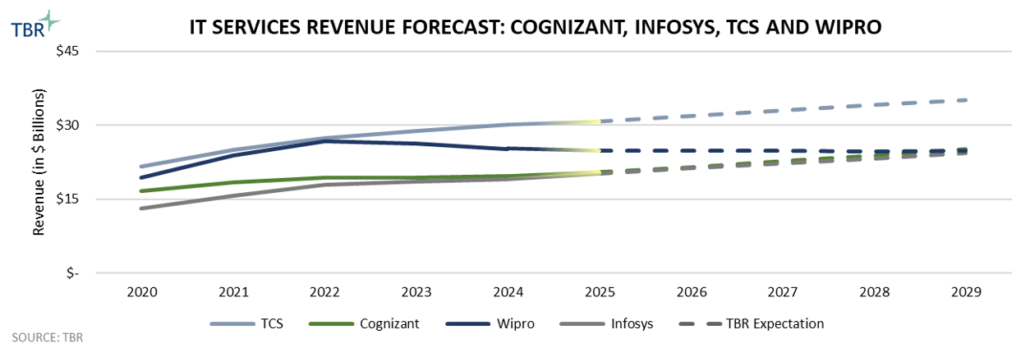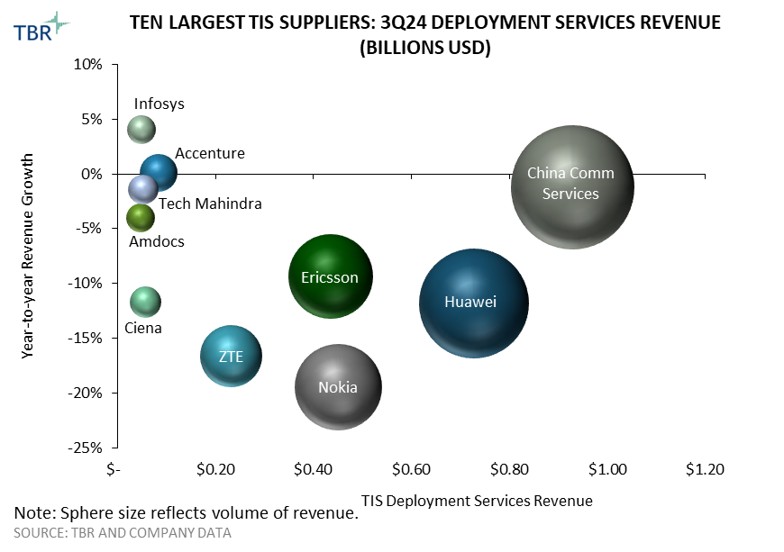DOGE Federal IT Vendor Impact Series: CACI
December 2025 Update: “Shutdown Ends, but Federal Contractors Face a Slow Return to Normal”
The Trump administration and its Department of Government Efficiency (DOGE) have generated massive upheaval across the board in federal operations, including in the federal IT segment. As of March 2025, thousands of contracts described by DOGE as “non-mission critical” have been canceled, including some across the federal IT and professional services landscape. TBR’s DOGE Federal IT Vendor Impact Series explores vendor-specific DOGE-related developments and impacts on earnings performance. Click here to receive upcoming series blogs in your inbox as soon as they’ve published.
CACI spared from major DOGE disruptions: Growth and profitability on track for FY25 goals
CACI tendered its 1Q25 earnings on April 23, and TBR did not discern any material impact from DOGE on the company’s business during the quarter, the third fiscal quarter of CACI’s FY25 (ending June 30). The company posted sales of $2.17 billion in 1Q25, up 11.8% year-to-year on a statutory basis and up 5.6% on an organic basis. CACI’s gross margin of 33.8% in 1Q25 was up sequentially from 33.2% in 4Q24, while its operating margin of 9.1% in 1Q25 was up 50 basis points sequentially from 8.6% in 4Q24. The company’s adjusted EBITDA margin was 11.7% in 1Q25, up from 11.1% in 4Q24.
CACI believes demand will remain strong through the remainder of its FY25 and into its FY26 for technologies and capabilities at the core of the company’s portfolio: AI-enhanced and commercially honed software-defined solutions delivered with Agile development methodologies; signals intelligence (SIGINT) and electronic warfare (EW) technologies for warfighters, defense vehicles and platforms, and IC applications; and AI-infused financial management offerings.
Uninterrupted sales growth and consistent margin performance indicate CACI’s offerings remain well aligned to the Trump administration’s IT investment priorities, particularly as the new administration prepares to expand investment in cybersecurity, national security and national defense, and advanced space-based communications systems for defense, intelligence and civil applications. CACI executives also noted that the federal budget environment is slowly becoming more constructive and more transparent, a positive harbinger for CACI and its fellow federal IT contractors.
CACI’s order book was essentially immune to DOGE-related turmoil in the federal IT market
TBR did not observe any impact from DOGE activities on CACI’s book of business. CACI’s backlog fell 1.3% sequentially, from $31.8 billion to $31.4 billion in 1Q25, but his kind of decline is typical in the company’s third fiscal quarter. CACI’s trailing 12-month (TTM) book-to-bill ratio was 1.5 in 1Q25, down from 1.7 in 4Q24. However, a sequential decline from the second to third fiscal quarter is not unusual for the company. In 1Q25, both the TTM book-to-bill ratio of 1.5 and the quarterly ratio of 1.2 were consistent with figures from the same period last year.
Furthermore, CACI’s bookings of $2.2 billion in 4Q23 and $3.5 billion in 1Q24 came during a period of exceptionally robust Department of Defense and Intelligence Community-related award activity. CACI’s bookings were $2.75 billion in 1Q25, up from $1.2 billion in 4Q24, consistent with the seasonal, historical pattern of sequential bookings expansion in the company’s third and second fiscal quarters. CACI noted in its 1Q25 earnings discussion that DOGE examined seven contracts in the company’s order book, including one that had already been completed. The aggregate revenue impact of these awards being eliminated by DOGE would only be $3 million in TCV, though DOGE has only notified CACI that $1 million worth of this ongoing work is likely to be canceled.
The company acknowledged that its business development teams have experienced some deceleration in certain aspects of the sales cycle, such as invoice and funding approvals. CACI CFO Jeffrey MacLauchlan said during the earnings call that “things that used to take two or three days are taking four or five days.” CACI’s leadership expects the disruption, which according to the company has been “very manageable” to date, to wane during the second half of federal fiscal year 2025 (FFY25). If sales motions are being impeded by DOGE, TBR would expect to see this reflected in lower-than-expected margin performance by CACI, but we did not observe any DOGE-related margin erosion in CACI’s P&L in 1Q25.
Undeterred by the DOGE-disrupted environment, CACI elevates several elements of its FY25 guidance
CACI raised the low end of its FY25 sales guidance range in 1Q25 and is now calling for top-line revenue of between $8.55 billion and $8.65 billion, implying a growth range of between 11.6% and 12.9% over FY24 revenue of $7.66 billion. In 4Q24 the company forecasted $8.45 billion in revenue at the low end of its projected FY25 sales range, implying growth of 10.3% at the bottom of the range.
CACI also raised the low end of its guidance for FY25 adjusted net income* in 1Q25 and now expects at least $543 million in FY25, up from $537 million forecasted in 4Q24.
CACI elevated its outlook for non-GAAP adjusted diluted earnings per share (ADEPS) in 1Q25, and as of 1Q25 is projecting a range of between $24.24 and $24.87 per share for FY25, up from a previous ADEPS range of between $23.24 and $24.13 per share. Free cash flow guidance was also elevated from $450 million tendered in 4Q24 to $465 million in 1Q25.
TBR notes that CACI has twice raised guidance for FY25 sales, adjusted net income, ADEPS and free cash flow since initially tendering its FY25 outlook in 2Q24. CACI is still guiding for a FY25 EBITDA margin in the low 11% range, implying a potential improvement of 100 basis points over FY24’s EBITDA margin of 10.4%, but also suggesting CACI does not expect any DOGE-related margin headwinds through the remainder of FY25.
CACI will remain vigilant and maintain a constant dialogue with customers
During CACI’s 1Q25 earnings call, CEO John Mengucci described DOGE’s objectives as “peace through strength, secure borders, increased efficiency and technology modernization.” Mengucci and his executive team remain confident that CACI’s strategy and portfolio are and will remain in sync with DOGE’s goals and with the IT strategy of the Trump administration, a contention supported by the company’s 1Q25 fiscal results and its more optimistic FY25 outlook.
Irrespective, CACI recognizes that federal executives are under pressure to accelerate IT modernization, quickly achieve IT-driven operational efficiencies and curb spending according to DOGE directives. Procurement teams at federal agencies are struggling to keep bid review processes and proposal adjudications on schedule as the Trump administration executes large-scale furloughs across the federal workforce. As such, CACI will keep its executives, business line leaders and business development teams as close as possible to IT decision makers and procurement counterparts in federal agencies for as long as DOGE’s efficiency agenda is in effect.
*Adjusted net income: GAAP-compliant net income excluding intangible amortization expense and the related tax impact
TBR’s DOGE Federal IT Impact Series will include analysis of Accenture Federal Services, General Dynamics Technologies, CACI, IBM, CGI, Leidos, IFC International, Maximus, Booz Allen Hamilton and SAIC. Click here to download a preview of our federal IT research and receive upcoming series blogs in your inbox as soon as they’ve published.




